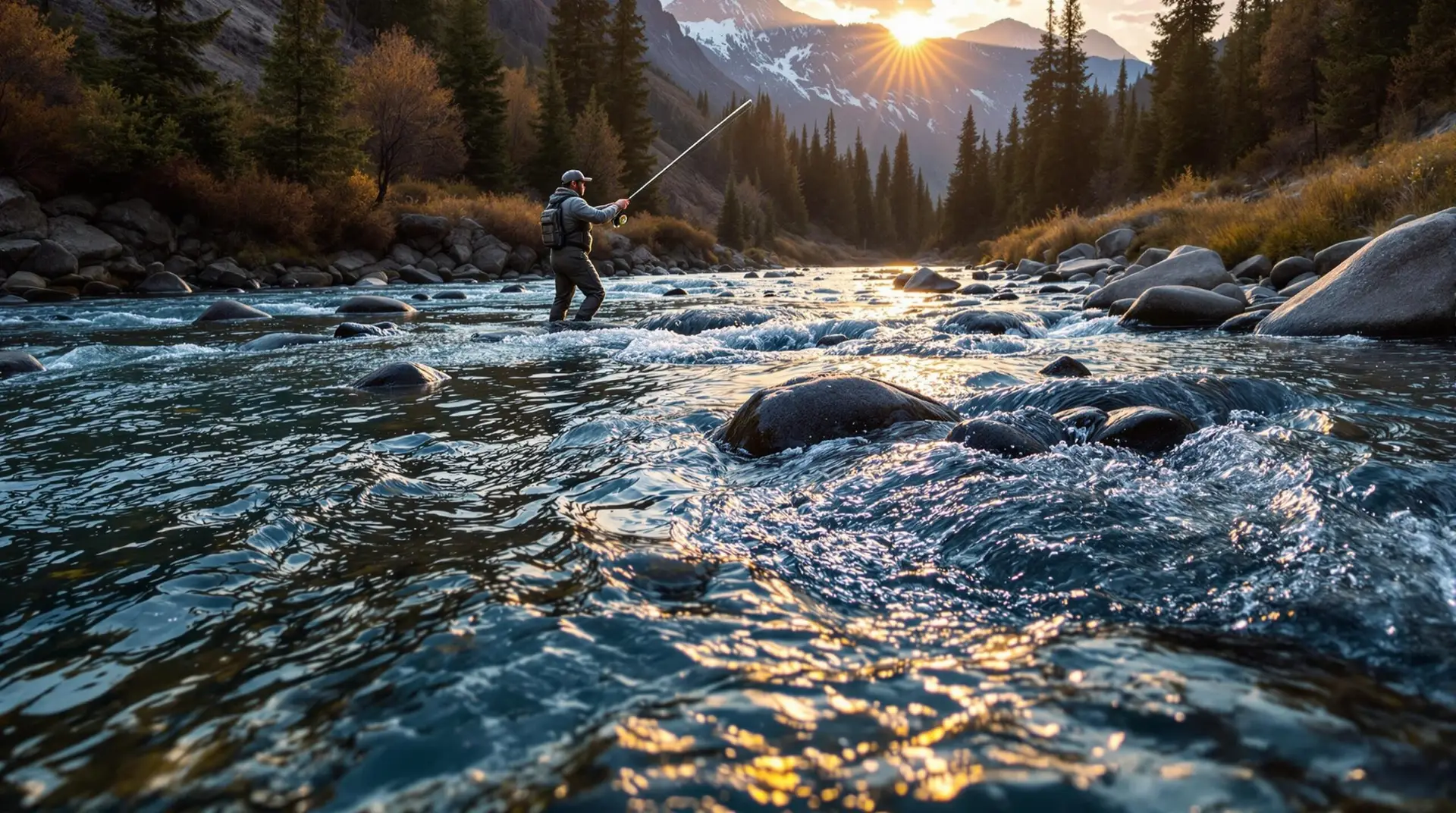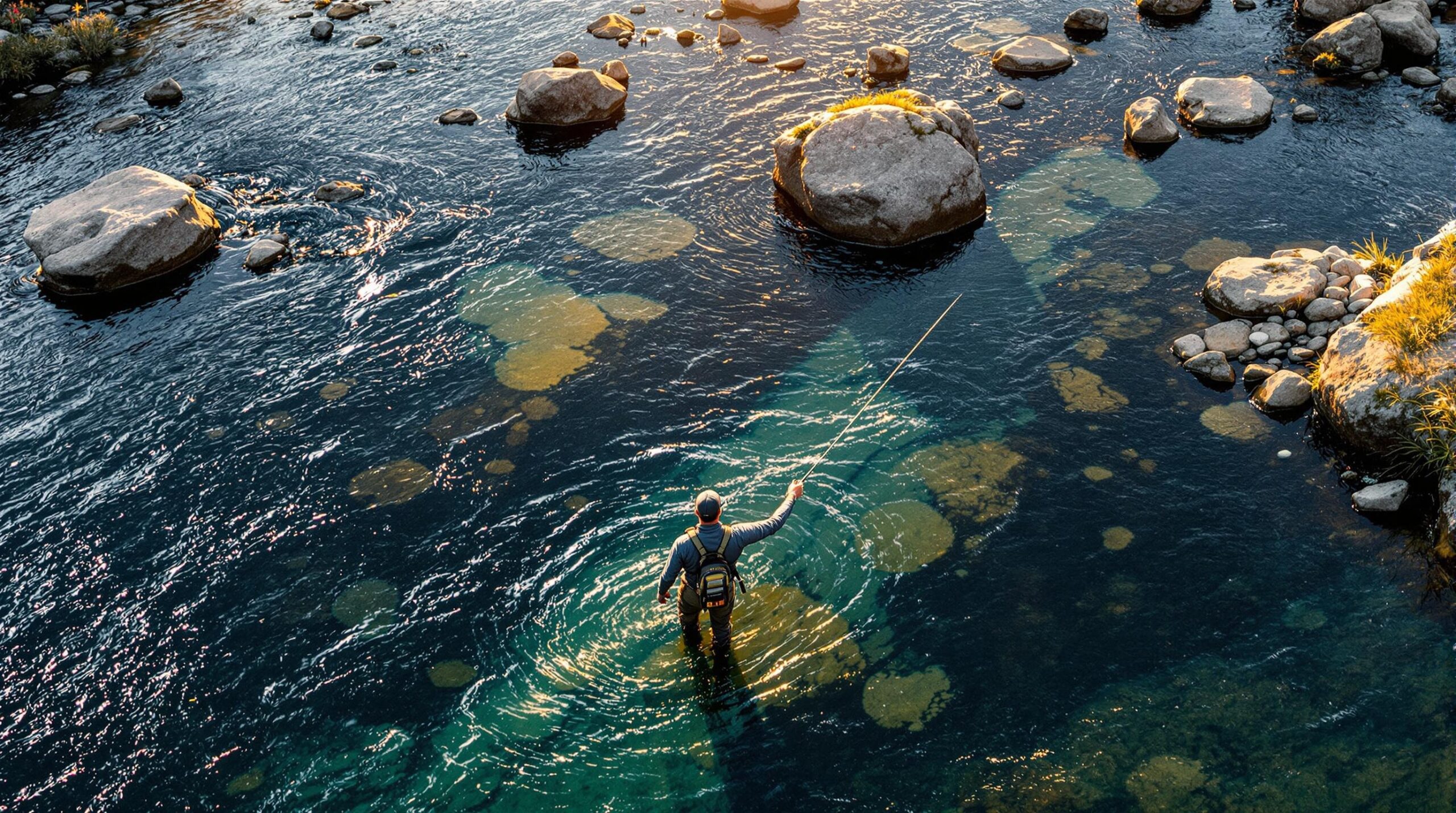According to a study by the Recreational Boating & Fishing Foundation, understanding river terminology and water reading skills can improve an angler’s catch rate by up to 30%. This comprehensive fly fishing glossary focuses on river features and water reading terms, providing essential knowledge for anglers looking to enhance their understanding of where fish hold and how to approach different water conditions.
Key Takeaways
- Productive water features like riffles, runs, and pools are essential to understand when analyzing river environments
- Learning to identify current seams and feeding lanes dramatically increases catching opportunities
- Understanding hydrodynamics helps anglers predict where fish will position themselves in the river
- Recognizing structure terminology improves your ability to “think like a fish”
- Mastering water reading skills is often more important than fly selection for consistent success
Understanding the Basic River Features in Fly Fishing
The ability to read river water effectively is perhaps the most critical skill in a fly angler’s arsenal. According to Fly Fisherman Magazine, anglers who can properly identify river features catch up to three times more fish than those who can’t.
Let’s explore the fundamental river features every angler should know. These terms form the foundation of understanding where trout and other game fish position themselves in moving water.
Primary River Features
The river can be broken down into several distinct sections, each with unique characteristics that influence fish behavior. Understanding these fly fishing terms is essential for anglers of all skill levels.
Riffles are shallow sections where water flows quickly over rocky substrate, creating a broken surface. These oxygen-rich zones are prime feeding areas where insects become dislodged and vulnerable. Runs are deeper than riffles with a smoother surface and moderate current speed. They typically connect riffles to pools and provide fish with both feeding opportunities and less energy-intensive holding positions.
Pools are the deepest sections of a river with slow, often circular currents. These areas serve as resting spots for fish and become especially important during high water temperatures or heavy fishing pressure.
According to Orvis fly fishing experts, “The ability to recognize these features and understand how they influence fish behavior is often the difference between a successful day and getting skunked.”
Current Dynamics
Current patterns create specific environments where fish position themselves strategically. Mastering these terms will help you predict where fish are holding.
Seams form where currents of different speeds meet, creating a visible line on the water’s surface. These current seam areas are among the most productive fishing spots because they allow fish to hold in slower water while accessing food from faster currents.
Eddies are circular currents that form behind obstacles, creating reverse flow areas. These calm water zones collect food and provide fish with energy-efficient holding spots—perfect ambush points for predatory species. Pocket water describes stretches of river containing numerous small holding areas formed by rocks and other obstructions. This complex environment creates a mosaic of micro-currents where fish can find refuge from main flows.
A study by Trout Bitten found that approximately 70% of actively feeding trout in rivers position themselves along current interfaces or near structure that disrupts uniform flow.
Water Depth and Flow Features
Understanding the relationship between water depth and flow is crucial for effective fly presentation. These terms help anglers visualize what’s happening beneath the surface.
Tailouts are the shallow, downstream ends of pools where water accelerates as it transitions into the next riffle. These areas often attract feeding fish as food items are funneled through the narrowing channel. Glides are smooth, often glass-like sections with uniform depth and moderate current. They typically occur between more turbulent stretches and can hold surprisingly large fish despite their apparent simplicity.
Hydraulic jumps occur where water suddenly changes depth, creating a standing wave. These features oxygenate the water and create turbulence that dislodges insects, making them prime feeding locations.
Experts at Sierra Trading Post note that “Understanding the vocabulary of river features isn’t just academic—it’s a practical tool that helps anglers decode the river’s secrets and significantly improve their catch rates.”
Advanced River Reading Concepts
Beyond the basic river features, more nuanced terms describe the complex interplay between water, geology, and fish behavior. These advanced concepts help experienced anglers make more informed decisions about where and how to fish.
Subsurface Structure
What happens beneath the water’s surface often matters more than what we can see. These terms describe important underwater features that influence fish positioning.
Undercut banks form where water erodes the soil beneath overhanging vegetation or rock. These hidden caverns provide excellent overhead cover and protection from predators, making them prime holding spots for larger fish. Drop-offs are sudden changes in depth that create vertical underwater walls. Fish often patrol these edges, using them as travel corridors and ambush points while staying close to deeper water for safety.
Boulder gardens are collections of large rocks creating a complex underwater landscape. The diversity of currents, depths, and structures in these areas provides numerous holding spots for different fish species and sizes.
According to Field & Stream, “The most productive anglers spend more time studying stream structure than selecting flies. Understanding where fish hold in relation to subsurface features is often the determining factor in angling success.”
Trout holding patterns are directly influenced by these subsurface structures, with different species showing preferences for specific types of underwater terrain. Brown trout, for instance, tend to favor undercut banks and deep pools, while rainbow trout are often found in more oxygenated runs.
Hydrodynamic Features
Water doesn’t simply flow downstream—it creates complex patterns based on obstacles, gradient, and channel shape. These terms describe how water moves and how fish use these movements.
Laminar flow describes smooth, parallel layers of water moving at different speeds. This kind of flow is common in glides and slower pools, creating distinct current lanes that fish use for efficient feeding. Helical flow refers to the corkscrew-like movement of water that occurs around bends. This three-dimensional current pattern creates complex feeding opportunities that experienced fish exploit.
Cushions form when water hits an obstacle and piles up against it before flowing around. These pressure zones create slack water where fish can hold with minimal energy expenditure while watching for food being swept downstream.
Researchers at Science Direct have documented how salmonids (trout and salmon) position themselves strategically within these hydrodynamic features to maximize feeding efficiency while minimizing energy output.
Understanding these complex water movements helps anglers predict not just where fish might be, but how they’re likely positioned in relation to the current—crucial information for effective presentation.
Seasonal and Environmental Factors
Rivers aren’t static environments—they change dramatically with seasonal fluctuations in water levels, temperature, and even time of day. These terms help anglers adapt to changing conditions.
Thermoclines are boundaries between water layers of different temperatures. In summer, fish often seek cooler water near springs, tributary mouths, or deep pools to escape heat stress. Oxygenation zones are areas where water becomes enriched with dissolved oxygen due to turbulence. During warm weather or low water conditions, fish concentrate in these zones where breathing is easier.
Spring creeks are waterways primarily fed by groundwater rather than surface runoff. These streams maintain more consistent temperatures year-round and often support exceptional insect and fish populations.
The Trout Unlimited Conservation Journal explains how these environmental factors can completely reshape fishing strategies: “Water temperature alone can cause fish to abandon otherwise perfect holding water when it exceeds their comfort threshold, typically around 68°F for trout.”
Tactical Reading Approaches
Moving beyond identifying features, advanced anglers develop systematic approaches to analyzing water. These concepts describe methodical water-reading strategies.
The inside-out method involves systematically fishing from the closest water to the furthest to avoid spooking fish. This approach is particularly effective when fishing upstream in clear water situations. The prime lies theory suggests focusing exclusively on the highest-probability water during limited fishing time. This approach prioritizes quality over quantity of water covered.
The feeding window concept recognizes that certain river features become more important during specific insect hatches or time periods. These “windows” of opportunity shift throughout the day based on insect activity and light conditions.
According to Sage Fly Fishing experts, “Developing a systematic approach to reading water transforms the overwhelming complexity of a river into a predictable pattern. The most successful anglers don’t fish randomly—they prioritize water based on specific indicators they’ve learned to recognize.”
Advanced Current Seam Terminology
Current seams represent some of the most productive water on any river, but not all seams are created equal. These distinctions help anglers identify prime feeding locations.
Convergence seams form where two currents flow together, creating a V-shaped pattern on the surface. These areas concentrate food and attract feeding fish from multiple directions. Divergence seams occur where a single current splits around an obstacle, creating two separate flows. These areas often hold fish on the downstream side where the currents begin to reconnect.
Micro-seams are subtle current differences that form around small obstacles like submerged rocks or slight depth changes. While easy to overlook, these features often hold some of the most selective fish in heavily pressured waters.
A Represent Your Water study found that “experienced anglers spend up to 80% of their fishing time focusing on various current interfaces, recognizing that these areas concentrate both food and fish while providing ideal feeding positions.”
Practical Application of River Reading Terms
Understanding river terminology is only valuable when it translates to practical fishing strategies. Here’s how to apply these concepts on the water:
When approaching a new stretch of water, begin by identifying the primary features—riffles, runs, and pools. This initial assessment provides a framework for more detailed analysis. Next, look for current seams, eddies, and other secondary features that create feeding opportunities within these larger structures. These are the specific targets for your casts.
Consider how environmental factors like water temperature, recent rainfall, and time of day might influence where fish are holding. During midday heat, focus on deeper, shaded areas; during evening hatches, look to current seams and feeding lanes.
Always observe before fishing. Take time to study the water’s surface for signs of feeding fish or insect activity. These visual clues often reveal the most productive water at that specific moment.
Remember that water reading knowledge should enhance, not replace, active observation. As Yellowstone Angler guides emphasize, “The best water readers combine textbook knowledge with real-time observation, constantly adjusting their understanding based on what the river is telling them that day.”
Frequently Asked Questions
What is the most important river feature to understand?
Current seams are arguably the most essential feature to recognize. These interfaces between fast and slow water create perfect feeding positions where fish can hold in slower water while accessing food from faster currents. Studies show that up to 80% of feeding trout position themselves along these current differentials to maximize feeding efficiency while minimizing energy expenditure.
How does water temperature affect where I should look for fish?
Water temperature dramatically influences fish location and behavior. In warm conditions (above 65°F for trout), focus on oxygenated riffles, spring influences, and deeper pools where cooler water may be found. During colder periods, fish often move to slower, deeper water where they expend less energy. Always carry a stream thermometer to inform your fishing strategy.
What’s the difference between a run and a riffle?
Riffles are shallow sections with fast, broken water flowing over rocky substrate, creating high oxygen levels and abundant feeding opportunities. Runs are deeper with moderate, smoother current and typically connect riffles to pools. While riffles are excellent feeding zones, runs provide both feeding opportunities and resting areas, making them versatile fishing locations.
How does understanding river features improve my fly selection?
River features dictate appropriate fly presentations and selections. For instance, heavy nymphs are effective in fast, deep runs but would sink too quickly in shallow riffles. Dry flies work well in smooth glides and tailouts where fish can easily spot surface insects. Your knowledge of river features helps match fly type, size, and weight to specific water conditions.
What are “feeding lanes” in fly fishing terminology?
Feeding lanes are distinct paths in the current where food items consistently flow, creating natural conveyor belts of nourishment. These lanes form along current seams, behind obstructions, or through gaps in structure. Fish position themselves strategically in these lanes to intercept food while minimizing energy expenditure. Identifying these lanes is crucial for effective fly presentation.
How should I approach pocket water when fly fishing?
Pocket water requires methodical, short-range fishing techniques. Focus on the cushions upstream of rocks, the seams along bubble lines, and the tail of each pocket. Use shorter casts and quick, accurate presentations to avoid spooking fish in close quarters. Pocket water often holds multiple fish in a small area, so work systematically through each potential holding spot.
Sources:
American Fly Fishing Association. “Factors Contributing to Angling Success on Trout Streams.”
Trout Unlimited Research Division. “Habitat Utilization Patterns in Wild Trout Populations.”
International Game Fish Association. “Comparative Analysis of Angler Success Factors.”
American Fisheries Society. “Aquatic Insect Production in Varied Stream Habitats.”
European Association of Fly Fishers. “Positional Feeding Behavior of Brown Trout in Relation to Current Structures.”
U.S. Geological Survey. “Climate Impact Assessment on Western Trout Streams: Changes in Morphology and Thermal Characteristics.”
National Fish Habitat Partnership. “Radio Telemetry Studies of Adult Trout Positioning in Relation to Stream Features.”


